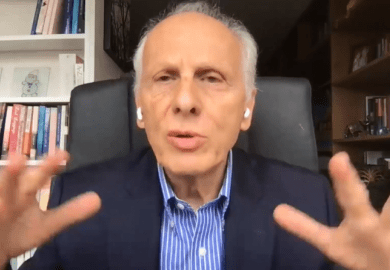View the THE Young University Rankings 2022 results
The UK has long been home to more of the world’s top young universities than any other nation. While the country’s higher education system may be most associated globally with the ancient spires and grand halls of the universities of Oxford and Cambridge, its leading institutions aged 50 years and under – many of them former polytechnics – have outnumbered those in the rest of the world since 2016. That is, until this year.
India and Turkey now lead the Times Higher Education Young University Rankings in terms of representation, with 40 institutions each, while Iran’s 37 universities share the third spot with the UK. Overall, the 2022 country list seems to back up the idea that we are now in the “Asian century”.
The young table, perhaps more than any other ranking, reflects global higher education policy developments. The UK’s lead was a result of two major policy changes – one in the 1960s that came in the wake of the landmark Robbins report on higher education that recommended a large expansion of the system, and legislation in the early 1990s which allowed dozens of institutions that were polytechnics to become universities. The universities that were established in response to the former have since left the ranking after reaching their 51st birthday.
India’s rise to joint top of the country list reflects the expansion in the number of Institutes of Technology in 2008, as well as the emergence of new private universities, in a bid to meet the aspirations of a growing middle class. The number of Turkish universities has also mushroomed since the 1990s in response to its growing population. The European University Association’s (EUA) Public Funding Observatory reports that student numbers in Turkey increased by a staggering 230 per cent, to almost 8 million, between 2008 and 2019.
Hans de Wit, distinguished fellow at the Center for International Higher Education at Boston College, says university expansion tends to occur in less mature higher education systems.
In many Asian and African countries, “demand is growing and supply is still insufficient because they have not been that strong in the past at offering higher education, so there is a strong need for more universities”, he says.
“That is quite different from North America, Europe and Australia, where we have now a kind of absorption rate of access to higher education.”
One of the new Indian players to join the ranking in the past two years is the Indian Institute of Technology Gandhinagar (IITGN), which ranks fifth in the country and joint 140th in the world, up from joint 155th last year.
Its founding director, Sudhir Jain, who was an academic at IIT Kanpur for 35 years, says he does not see the institution as “a poor cousin of the old IITs” – which are among the most prestigious universities in the country – but rather as “a next-generation IIT”.
“Just as every father wants his children to do better than [he] did, I too am on a mission that IITGN will be a superior IIT,” he says.
One way in which IITGN differs from its elders, according to Jain, is its focus on students, who are always “the first priority”.
“What that means is giving them a significantly superior educational experience and preparing them for life – not for their first job but for their last job,” he says.
Academics are now assessed not only on how many research papers they have written and how many PhD students they have supervised but also on the outcomes of those PhD students, such as where they are working now.
“We are still focusing on research, but we are trying to see it from the prism of the students,” he says.
Jain has also emphasised interdisciplinarity during his leadership.
“A subject is not the monopoly of the professor who has got a degree from that discipline,” he says.
“If you are a physics professor, you don’t own physics. Somebody in English literature could also own physics and want to teach physics. At IITGN, almost 15 per cent of students have a PhD supervisor who is not in their own discipline…because when you have interdisciplinary knowledge, you can solve real problems. You have the urge to have impact.”
Jain acknowledges that it will take time before IITGN is recognised in the same way as the older IITs – but he believes the institution will get there.
“There is no hurry; we are not in a 100-metre race, we are in a marathon,” he says.
Indeed, while several Asian countries have more universities in the young ranking than ever before, in many cases these institutions have not reached the upper ranks. India’s top representative, the private JSS Academy of Higher Education and Research, is joint 70th; Turkey’s highest position is joint 89th and Iran’s is 67th.
And while four of the top 10 places are filled by institutions in the continent, this is a drop from six last year due to the decline of two South Korean universities. A French institution – Paris Sciences et Lettres – PSL Research University Paris – takes the number one spot away from Nanyang Technological University, Singapore, making it the first time that an Asian institution has not led the table since 2017.

France’s rise to the top spot is also matched by an increase in its number of ranked institutions in recent years; 24 of its universities feature in the table, up from 16 five years ago. Seventeen of these institutions were founded in the past 10 years and five are in the top 20, more than any other nation.
However, the rise in young universities in France is a very different trend from that in India or Turkey; it is less about an expansion of the country’s higher education system and more about consolidation through the process of grouping together – and sometimes merging – existing institutions. The development is part of a government drive to create several “mega universities” that will be more visible on the global stage.
One of these is Institut Polytechnique de Paris, which joins the ranking for the first time this year in sixth place. It was founded in 2019 following the grouping together of five small engineering schools.
Its president, Eric Labaye, says “scale matters”, not just from the point of view of attracting the attention of students, staff, funders and higher education partners from around the world but also in terms of having the critical mass to be able to undertake impactful research and innovation projects. The institution now has three interdisciplinary centres on energy and climate, AI and data analysis, and defence and cybersecurity, while a fourth centre on biomedical engineering is in the works.
Another development Labaye is particularly proud of is Polytechnique Insights, a free online magazine modelled on the Massachusetts Institute of Technology’s Technology Review. It offers insights on the socio-economic implications of research and innovation and “the major movements affecting the world” in the fields of environment, health, natural resources, finance and demographics. Its website says the initiative is “a vector for the international reputation of the Institut Polytechnique de Paris”.
“None of the schools could have done this by themselves. We needed a critical mass for that,” says Labaye.
“We already have 40,000 subscribers. It’s a way of communicating to a broader public the scientific outcome of Institut Polytechnique.”
While Labaye says improving in the rankings was not the first objective, its strong league table performance is “testimony” that “getting the five schools together is working”.
“It has raised visibility,” he adds.
But Enora Bennetot Pruvot, deputy director of governance, funding and public policy development at the EUA, says that merging institutions is not a foolproof way of improving research performance or international visibility.
“There are mergers that could actually drive down in places some very famous institutions or institutions quite recognised in the rankings, if you join institutions that have very different profiles,” she says.
“In France, there was a strong rationale, because of the nature of how the French system was set up and the post-1960s division of universities into what we would normally call faculties.”

Pruvot says there is unlikely to be much more higher education expansion in Europe, but mergers have been popular across the continent over the past 15 years, sometimes due to declining youth populations, and are likely to continue to some extent.
In many cases, grouping together universities in the 2010s was seen as a way to save costs in the wake of the economic crisis – but Pruvot cautions against this logic, too.
“Those expectations about efficiencies and driving costs down have not proven true because mergers actually require a lot of investment. The chances of success are higher when you don’t drive these processes through very hard times,” she says.
But she says there is now more understanding about how complex these processes are and many of the recent consolidation projects have been about responding to local needs or increasing differentiation in the system.
New legislation enacted in Ireland in 2018, for example, has allowed institutions to group together and apply to be designated as a “technological university”. So far, one such institution has been created – Technological University Dublin in 2019, which ranks in the 351–400 band in the young ranking – but four other consortia are engaged in the process. The government says technological universities will address the social and economic needs of their region, focus on science and technology programmes that are vocationally and professionally oriented and engage in industry-focused research.
Global tertiary education expert Jamil Salmi says some Asian countries are likely to move more towards consolidation than the creation of new universities as well.
“Thailand, Taiwan and South Korea share the same issue of diminishing population coming out of high school – just like the eastern European countries and Russia,” he says.
“I think the only place where you’ll still see expansion is the Middle East and Africa.”
However, Salmi says it is unlikely that these newcomers will reach the top of the young or world rankings.
“Very few of them will have the financial base and the strategic objective of becoming strong research universities,” he says.
De Wit similarly says it is doubtful that the new upstarts will cause a stir among the established players any time soon – a view that ambitious leaders like Jain and Labaye may choose to see as motivation.
“Even if you look at China, the dominant universities are the old dominant universities. If you look at young research universities in Europe, they are not doing bad, but they are not really among the top research universities,” De Wit says.
“Even those that are now close to 50 years old have not been able to accomplish that.”
POSTSCRIPT:
Print headline: Youth movements
Register to continue
Why register?
- Registration is free and only takes a moment
- Once registered, you can read 3 articles a month
- Sign up for our newsletter
Subscribe
Or subscribe for unlimited access to:
- Unlimited access to news, views, insights & reviews
- Digital editions
- Digital access to THE’s university and college rankings analysis
Already registered or a current subscriber? Login








